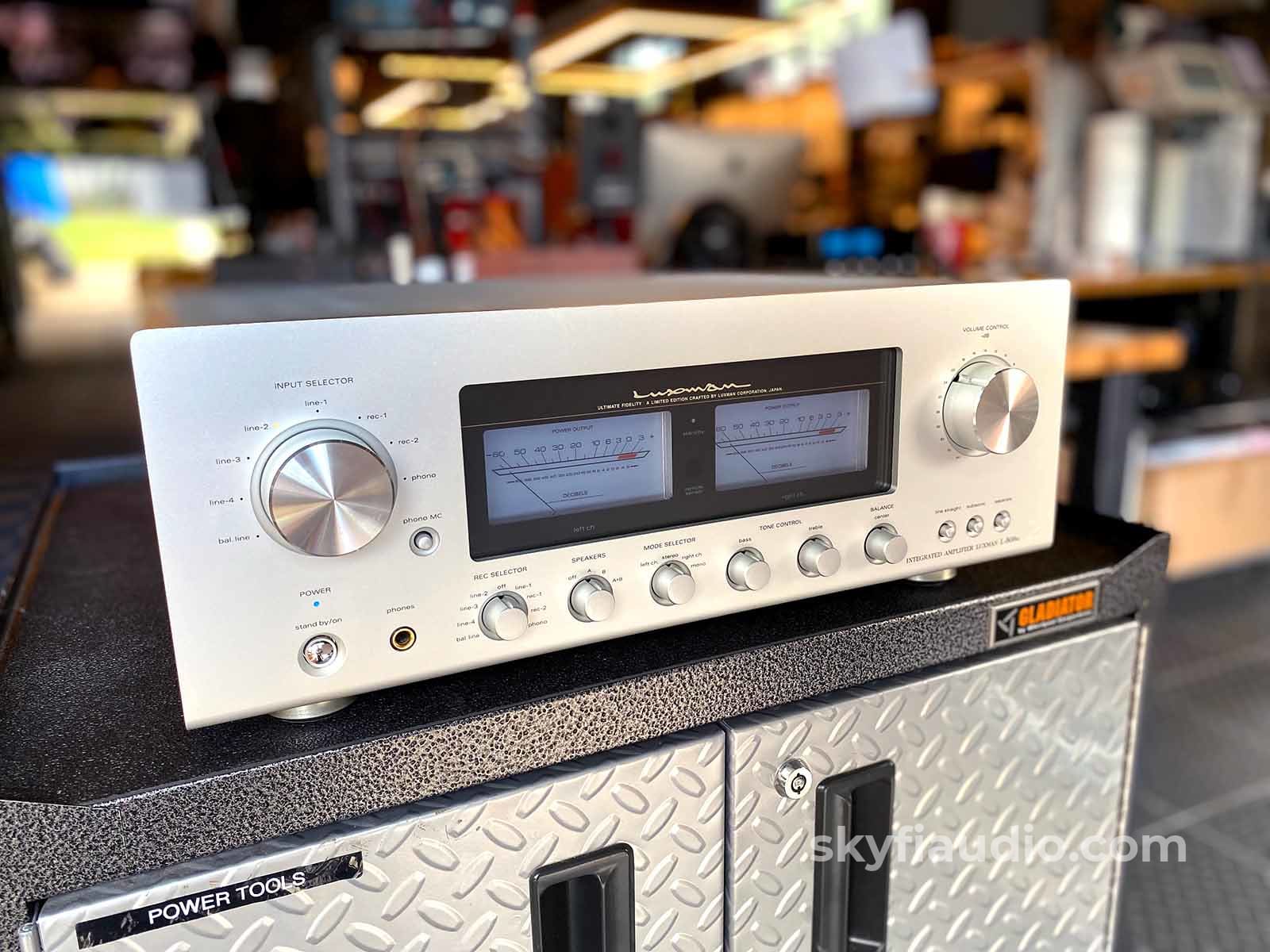
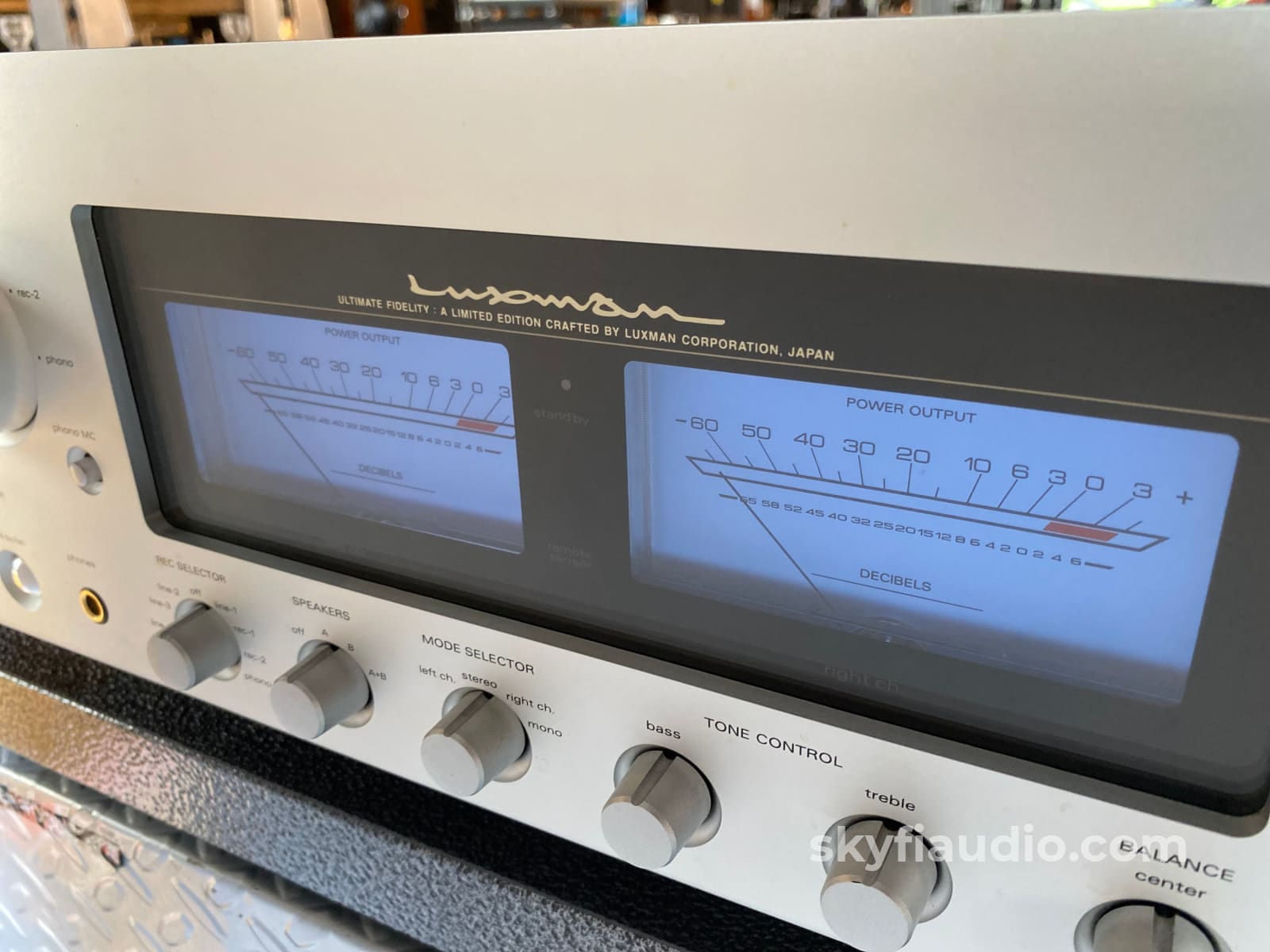
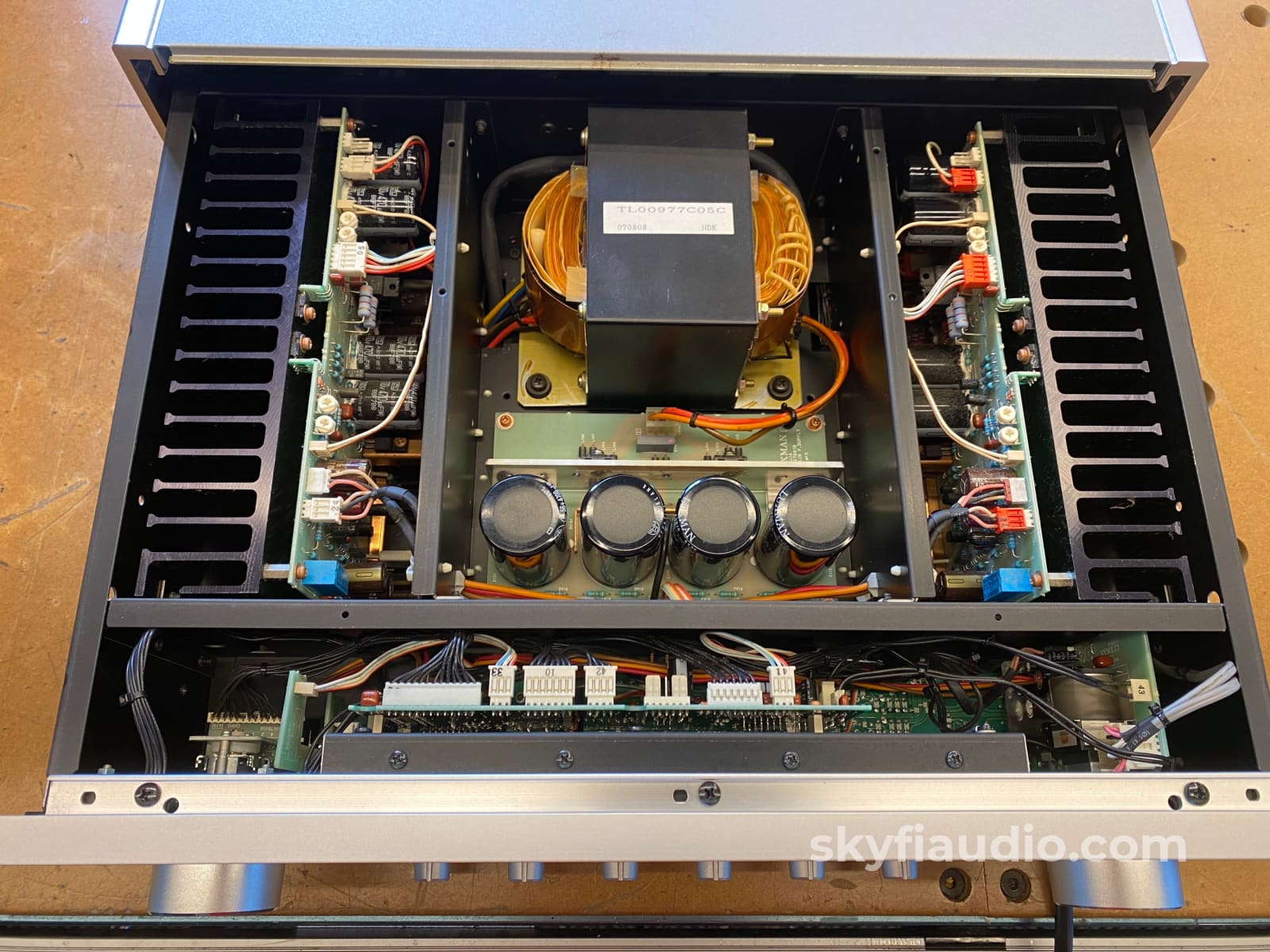

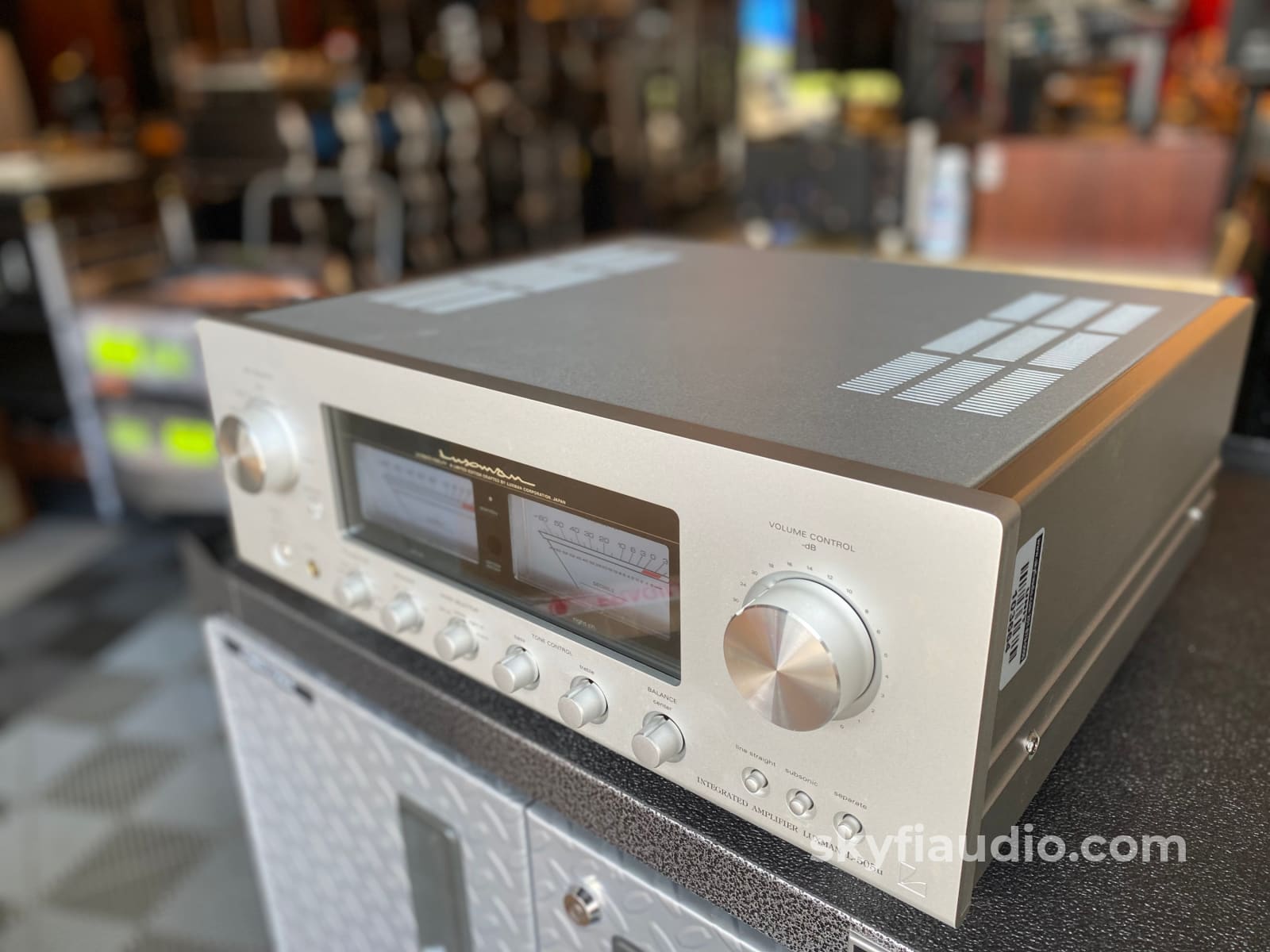

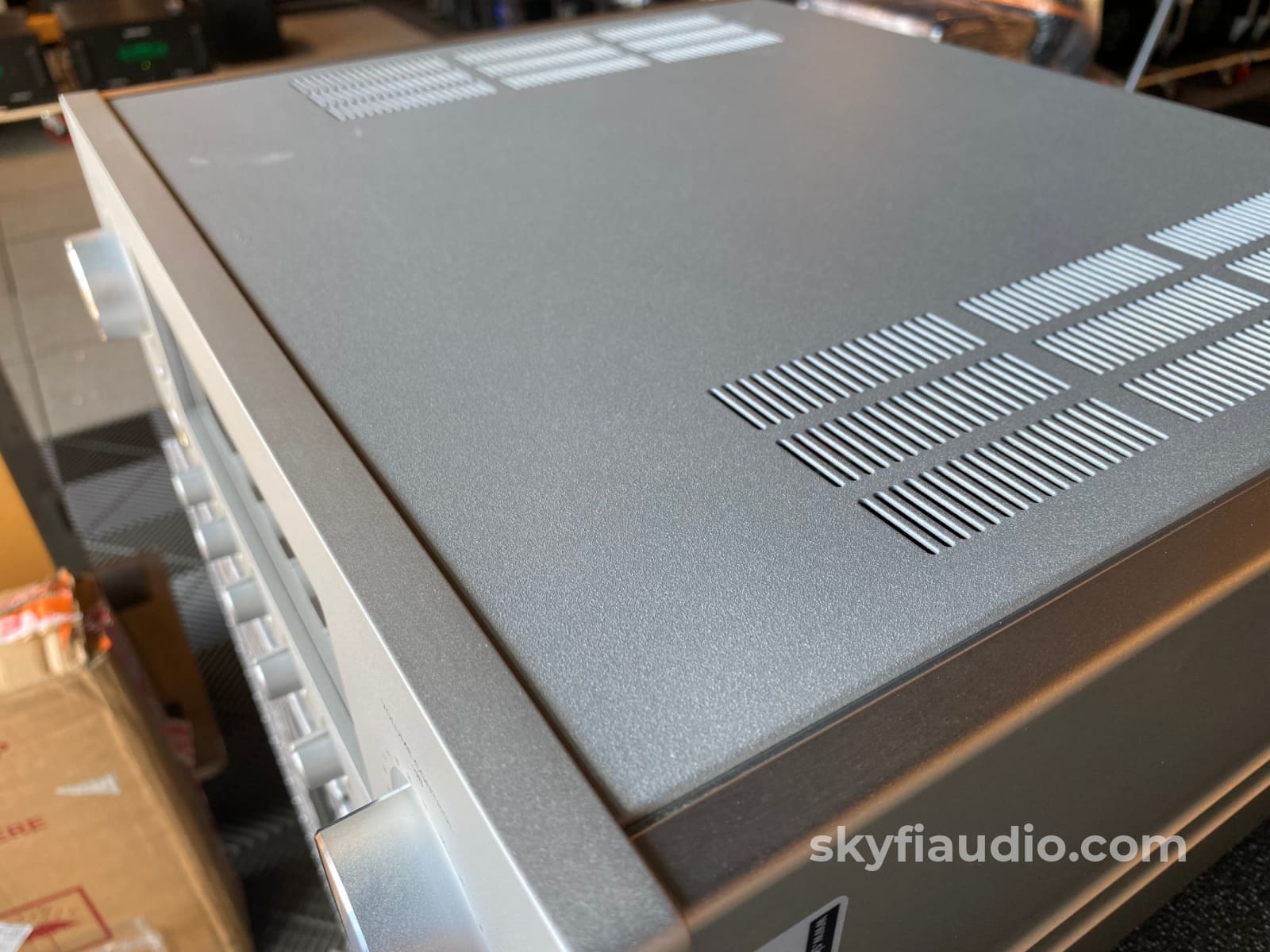
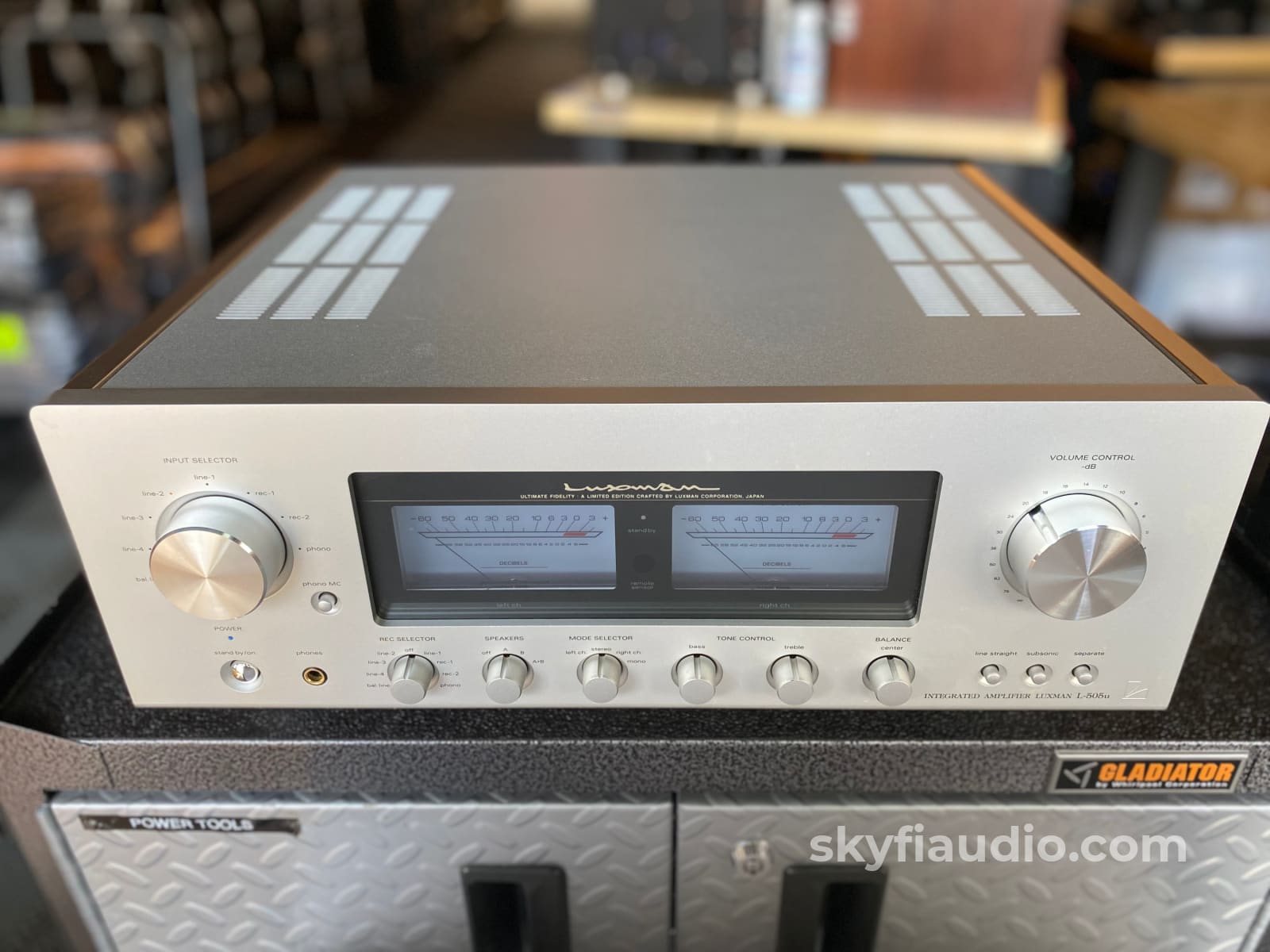

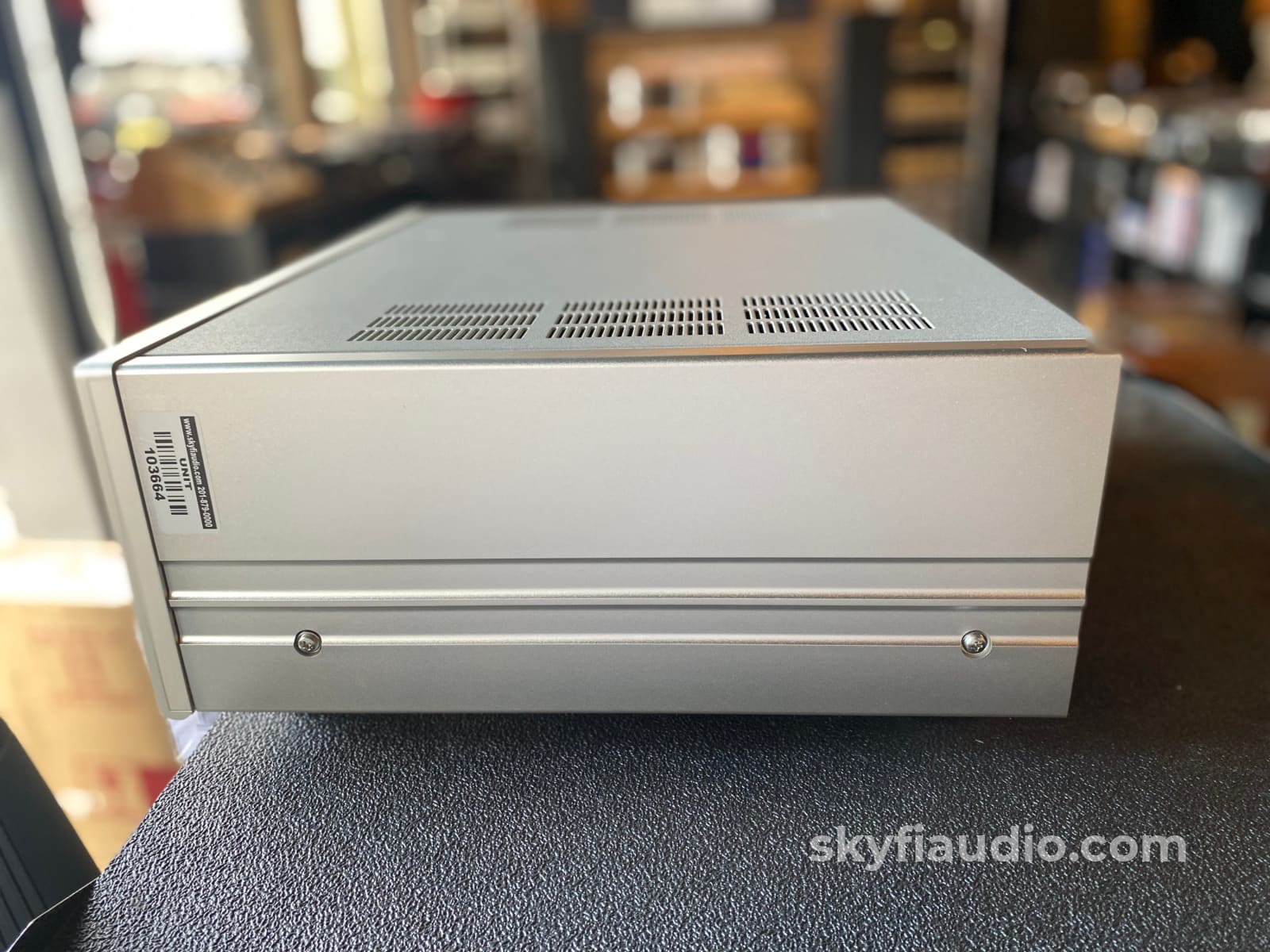

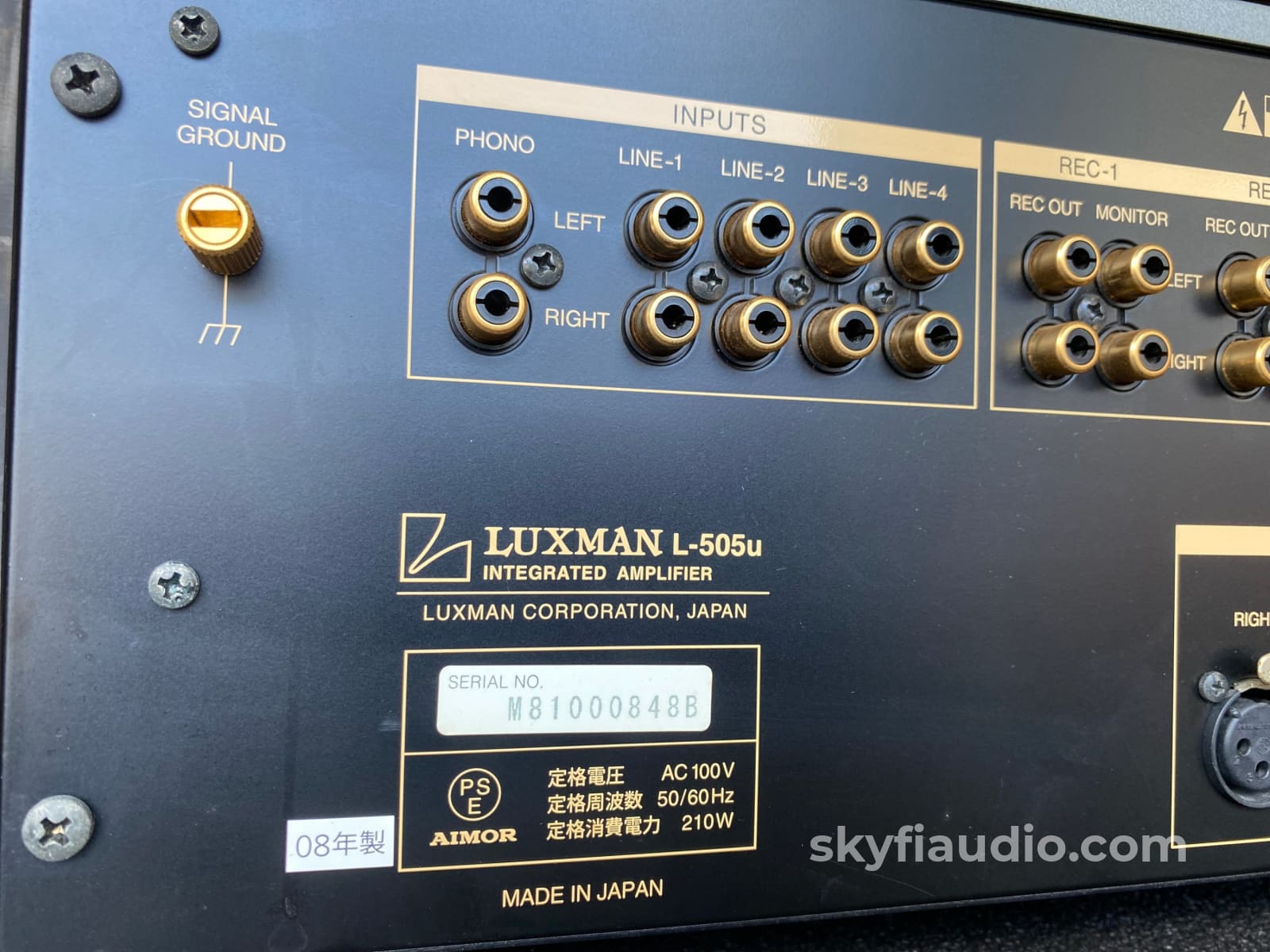
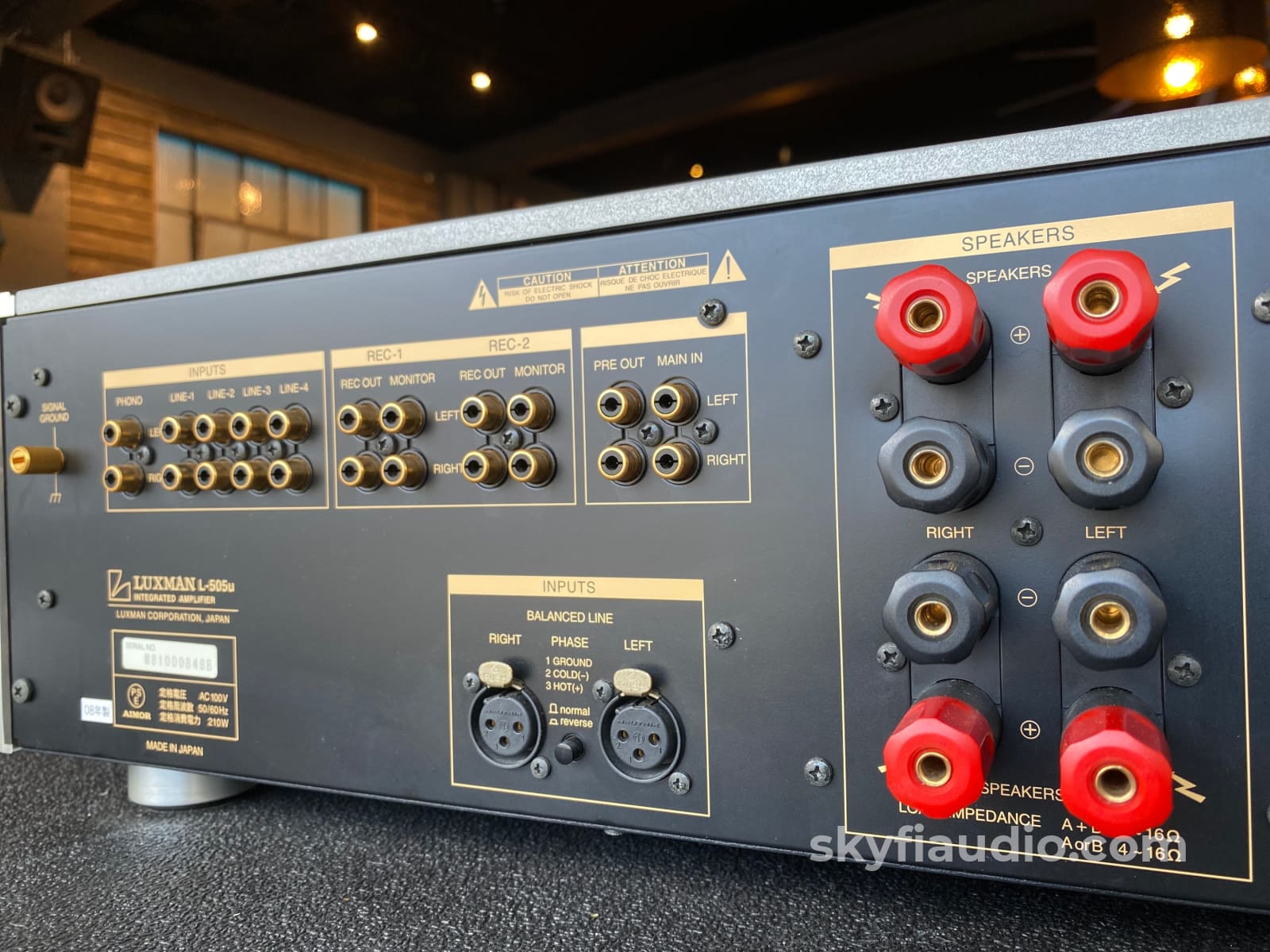
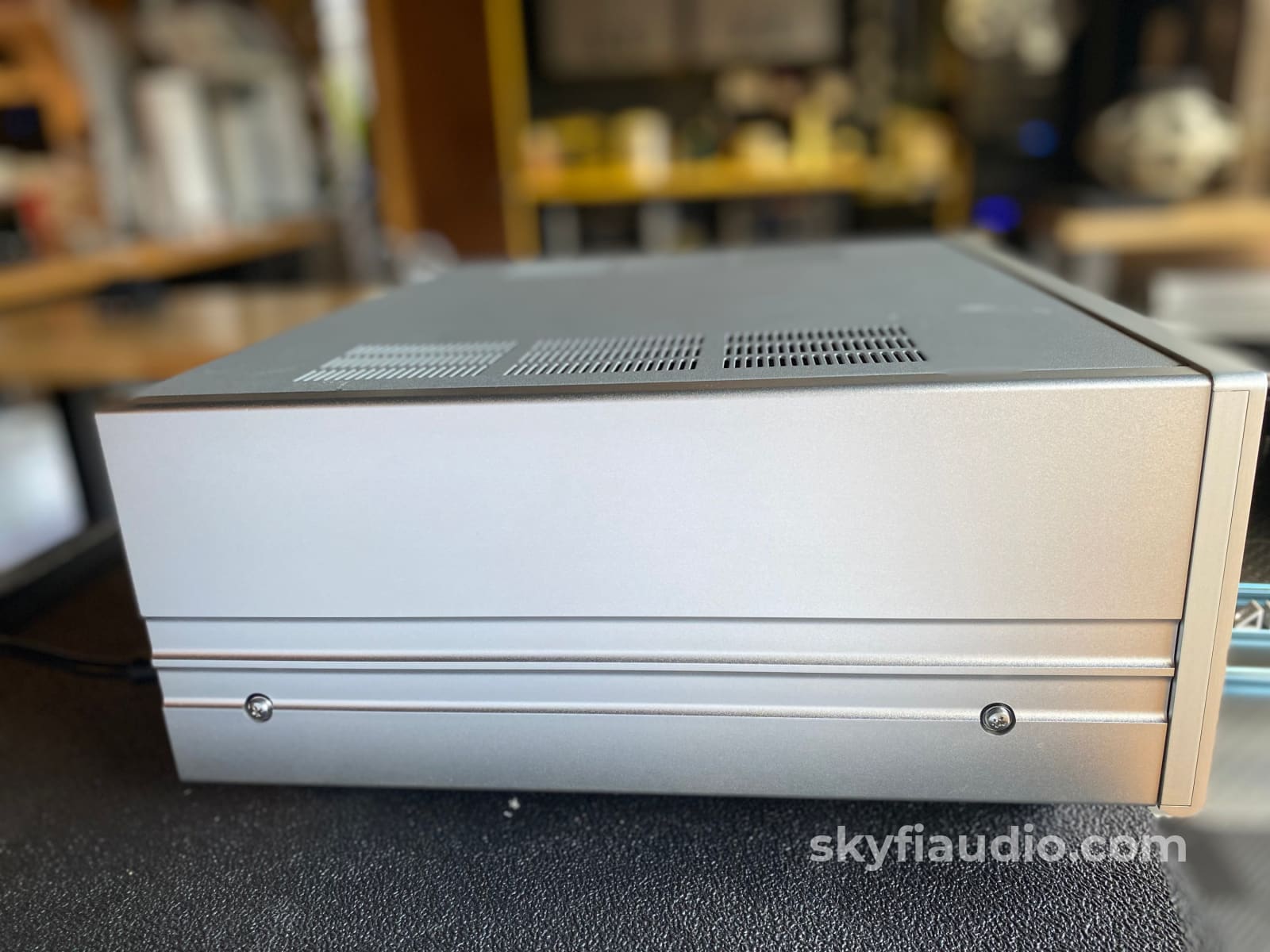
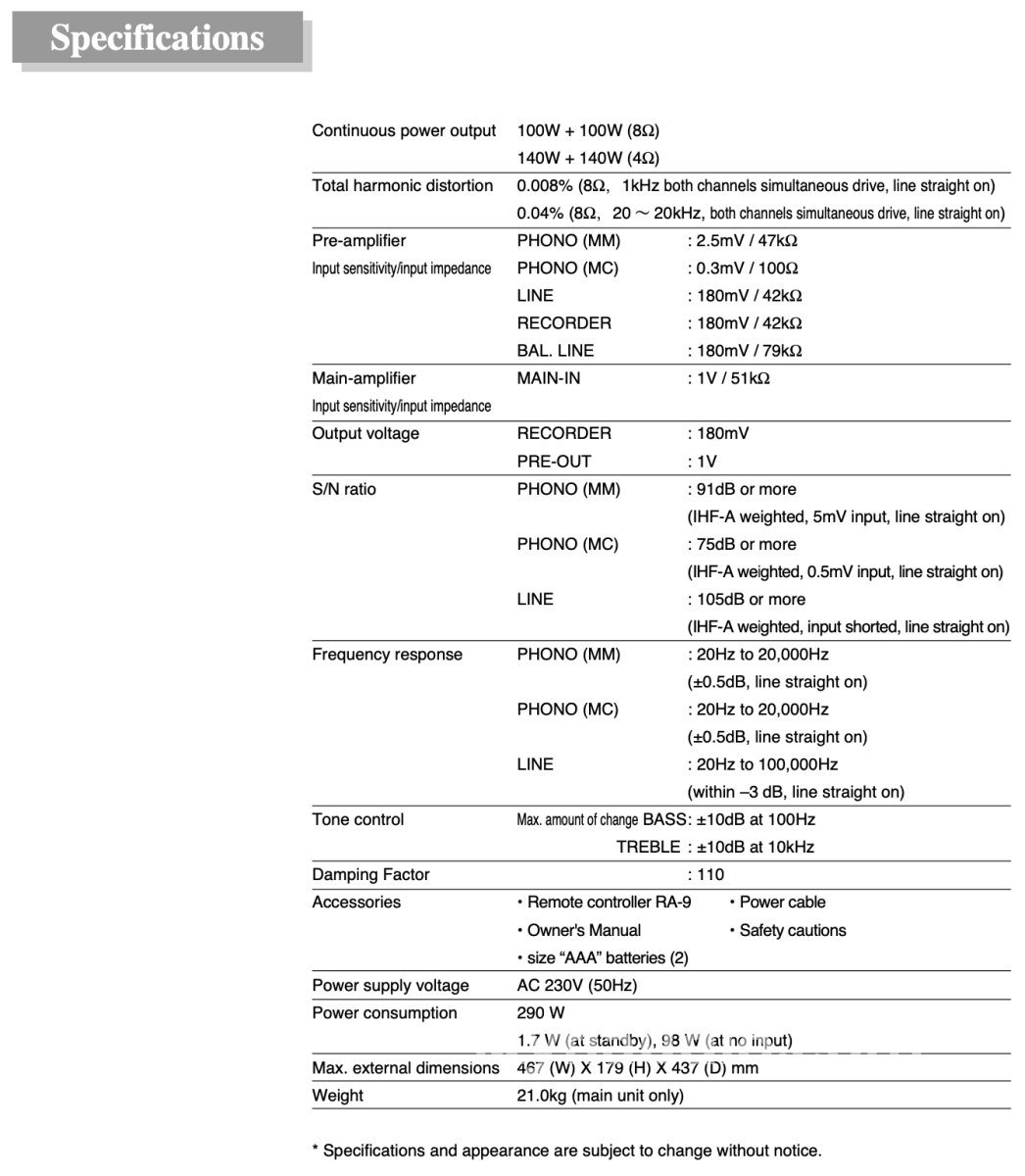
Luxman L-505u Integrated Amplifier with Phono and Meters
Free Shipping on Most Electronics - Excludes Speakers and Items Requiring Freight - Contiguous U.S. Only
Pickup currently unavailable at SkyFi 479

Luxman L-505u Integrated Amplifier with Phono and Meters
SkyFi 479
479 South Broad Street
Glen Rock NJ 07452
United States
If you follow our store you probably know we are huge fans of all Luxman equipment. This piece is no different.
This gorgeous L-505u is a Japanese market Luxman integrated Amp capable of being the heart of your HiFi system. Full of great features like VU power output meters, both MM and MC phono Inputs, balanced input, pre-amp outputs (in case you'd like to use it as a preamp) and typical super high-end Luxman construction.
This integrated came into our shop configured for 100VAC operation. We have adjusted the standby transformer primary for 115V operation and biased the output stage at 120VAC mains level to match the original bias level.
It has tested perfectly in our listening room and our lab where it produced the rated power of 100W (enough for most speakers).
Included with your purchase is the Luxman integrated amplifier and a power cord.
Click below to add our recommended matching cables from Kimber Kable, all brand new as SkyFi is an official Kimber dealer.
Kimber Kable - RCA Interconnects - Better
Kimber Kable - RCA Interconnects - Best
Ascent Series Hero Analog Interconnects (PAIR) - BALANCED XLR Connectors
Kimber Kable - Speaker Cables - Good
Kimber Kable - Speaker Cables - Better
Kimber Kable - Bi-Wire Speaker Cables - Best
Kimber Kable - Power Cords - Good
Kimber Kable - Power Cords - Better
Kimber Kable - 14AWG (Gauge) Power Cords - Best
Please see our photos or the linked manual below for full specifications:
Luxman L-505u Integrated Amplifier - Owner's Manual
Great review from Scott Hull @ Part Time Audiophile:
This babylux does not disappoint. It’s got knobs and dials and glowing bits galore — and I have to say, it sounds fantastic. So much so that I’m not sure anyone would need to go “higher” on the Luxman food chain. 100wpc is more than enough for all but the most demanding speakers (where “demanding” = poorly designed, IMO) — so the only real reason to go for more power is audiophile oneupsmanship. This amp drives my Magnepan 3.7s just fine, thank you very much — I know. I tried it. Here’s another tidbit — the L-505u runs warm, but not hot, unlike it’s pure-Class-A stablemates like the 550 and 590. Much better for that desk, that’s all I’m saying.
But all that might be — and since I’m talking to audiophiles here, let me change that to should be — secondary to the sound of amp. And here, I hope I’ll be pardoned for the blasphemy, but here goes: when compared to the $10k+ Class A Luxman L-590a Mark II, I dramatically prefer the $4k Class A/B Luxman L-505u.
This is all a subjective, personal-opinion thing, but in this one person’s very personal opinion, the L-590a Mark II that I had the privilege to audition with my Merlins last year, may well have been the finest amp I’ve ever had the pleasure to hear. I loved that amp. Sadly, the amp doesn’t make the system. In that particular case in point, I really didn’t think the amp’s native coloring, a rich and warm mid range with just a hint of roll off at either frequency extreme, just wasn’t a good match for Merlin speakers. In short, it was too much of a good thing — the Merlins were already warm and rich in the mid range. I added the Class A Luxman and found that things went from warm to syrupy and the smooth Luxman sound became cloying. But I can think of a hundred other speakers where this rich character would launch the lucky audiophile right off-planet. Just not the Merlins. And, to a lesser extent, not the Joseph’s either. I’ve said elsewhere that I think the Joseph Audio “house sound” bears more than a passing resemblance to Merlin, so this isn’t surprising.
Which brings me to the L-505u and the Luxman Class A/B amp. With the Pulsars, the combo is breathtaking. Treble has copious air and sparkle. Bass has both bombast and delicacy. And, of course, this Luxman absolutely nails the mid range. This is what system synergy is all about. Want to get off the audiophile train? Here’s an exit. This combo will last you a life time — it really is that good. If you can, just do yourself a favor — get ’em both and stop.
For many, however, this combo’s price tag will be prohibitive. I get that and I’m there, too. I wish I had even close to $12k available or this would be mine. I have no idea where I’d put them (the desktop is obviously not optimal), but that’s almost beside the point. I sure do want them. If I had anything close to $12k, I’d be haggling the hell out of my poor dealer.
Fine then. Call it an “aspirational system” and have done. When your stars align, and all that.
The SkyFi Testing Process for Preamplifiers:
We start with a visual inspection of all internal components to make sure that there are no signs of heat stress or damage. Capacitors are checked for telltale signs of predictive failure including bulging, shrunken wrappers, or physical leakage. We also inspect the PCBs for discoloration from resistors or transistors that may have been running hot. On vintage units we often spot check select capacitors for value and ESR.
When we first power on a preamplifier we connect its RCA output to a Sencore PA81 Power Analyzer which simulates real world loading conditions and gives us an oscilloscope interface. The first order of business is checking that the volume control works smoothly throughout its entire range with acceptable channel balance. This is accomplished by feeding a 1KHz sine wave into one of the preamp’s line level inputs while monitoring the preamp’s output on an oscilloscope. We then switch to a 1KHz square wave to test the tone controls, loudness function, and filters where applicable. During this step we are watching for equal alteration of the test signal by both channels. This also helps us identify dirty controls that will need treatment. Once the basic line stage functions are verified, we test each input individually. This is especially important for devices that use relays to select their sources. If the preamp is equipped with a phono stage we test that as well. We use an inverse RIAA filter which allows us to feed a reference test signal into the phono input with the proper RIAA equalization and level. A square wave or sine sweep is used to verify that the device’s phono stage is faithfully reproducing the RIAA curve. If the preamp under test has balanced inputs and/or outputs these are tested as well.
We finish up our bench testing with a listening test with our bench amplifier and reference speakers. During this test we check for hum or hiss that may not have shown up in earlier testing. We also check that all of the tone controls and filters perform as expected. If the preamplifier has remote control functions these are also tested. Preamps with tube circuits or complicated power supply topologies are connected at our long term test rig for extended stress testing under real world conditions.
The SkyFi Testing Process for Solid State Amplifiers:
We start with a visual inspection of all internal components to make sure that there are no signs of heat stress or damage. Capacitors are checked for telltale signs of predictive failure including bulging, shrunken wrappers, or physical leakage. We also inspect the PCBs for discoloration from resistors or transistors that may have been running hot. On vintage units we often spot check select capacitors for value and ESR.
If the amplifier passes visual inspection, we move on to a controlled power on sequence using a Sencore safety analyzer to monitor current draw in real time. Once the amplifier is determined to be safe to operate, we connect it to full AC mains for function and power testing. We connect the speaker outputs of the amplifier to a Sencore PA81 Power Analyzer which acts as a dummy load, DC offset monitor, and oscilloscope interface. We start with a low level 1KHz test signal at the amplifier’s input and slowly increase its amplitude while monitoring the output on an oscilloscope for signs of noise, clipping, distortion, or improper channel balance. We continue increasing the signal level until the amplifier reaches clipping. At this point we take an output power measurement and compare it to the spec sheet of the amplifier to verify proper performance. If the device under test has both balanced and single ended inputs they are both tested at this time. We finish off the bench evaluation with a 1KHz square wave check and a 20Hz to 20KHz sine sweep to assess the amplifier’s frequency response characteristics. This battery of tests will usually reveal if the amplifier has any issues that need further attention.
Before the device leaves the bench, we perform a listening test with actual music using a variety of preferred test tracks. Our benches are outfitted with familiar monitor speakers which help us identify inconsistencies that will not always show up on our test gear. The main things that we are listening for are hum or noise with no signal present, proper center image, clicks, pops, or any other obvious undesirable audio characteristics.
If the unit passes all of these tests it is moved to our long term testing rig where we simulate real word operating conditions for 6-8 hours. This allows us to monitor the unit for signs of thermal runaway or intermittent issues that only crop up when the unit has fully come up to temperature.
|
Item |
Included |
|
Original Box |
Not Included |
|
Manual |
Not Included |
|
Remote |
Not Included |
|
Cables |
Yes - Power Only |
|
Physical Condition |
7 / 10 |
|
Working Condition |
10 / 10 |
Choose options















